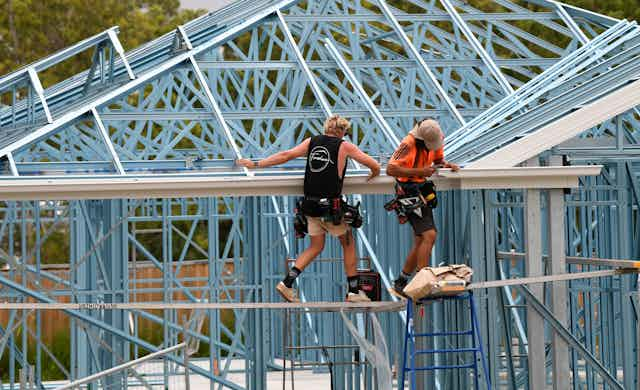Australia has an acute shortage of housing. Renters across the country face steep rents rises and record-low vacancy rates.
At the same time, net overseas migration has surged to a record high of 518,100 in the past financial year as international students, working holiday-makers, and sponsored workers returned to Australia after our international borders reopened and fewer migrants departed.
The trouble is, very few migrants arriving in Australia come with the skills to build the extra homes we need.
Migrants are back but lack home building expertise
Migrants are less likely to work in construction than in most other industries. About 32% of Australian workers were foreign born, but only about 24% of workers in building and construction were born overseas.
And very few recent migrants work in construction. Migrants who arrived in Australia less than five years ago account for just 2.8% of the construction workforce, but account for 4.4% of all workers in Australia.
Most migrants who work in construction in Australia have been here for a long time. The largest migrant groups in construction are permanent skilled migrants (including their spouses and children), followed by New Zealand citizens (who can remain in Australia indefinitely on a temporary visa) and permanent family visa-holders (many of whom arrived in Australia long ago as the spouses of Australian citizens).
But among those migrant groups where we’re now seeing the biggest rebound in numbers – international students, international graduates and working holiday makers – relatively few work in construction. And just 0.5% of all construction workers are on a temporary skilled visa.
Changing this situation won’t be easy. After all, Australia rightly wants to attract highly skilled migrants who will make the biggest long-term contribution to the country.
That means selecting highly skilled migrants – mostly tertiary-trained professionals. However, the construction workforce is one of Australia’s least educated. Just 22% of Australia’s construction workforce hold a diploma-level qualification or higher – the least of any industry.
What the government should do
But there are steps the federal government can take to make Australia more attractive to skilled trades workers who can help build the homes we desperately need.
First, the government should make it easier for employers to sponsor skilled trades workers to get a visa.
It should abolish labour-market testing and reduce sponsorship fees for the new “Core Skills” temporary sponsored visa stream – for skilled workers earning between A$70,000 and A$135,000 a year – to encourage more skilled trades workers to migrate to Australia.
The introduction of labour-market testing and extra fees like the Skilling Australians Fund Levy are big reasons why the number of visas granted to temporary sponsored workers in construction has fallen from more than 9,000 in 2011-12 to just 4,021 in 2022-23.
Read more: Australia's skilled migration policy changed how and where migrants settle
The government should also extend its new streamlined, high-wage “Specialist Skills Pathway” sponsored visa stream to skilled trades workers.
That pathway will be offered to workers who earn at least $135,000 a year. Visas will be approved in a median time of just seven days. Yet skilled trades workers earning more than $135,000 won’t qualify for the new streamlined pathway.
Second, the government should streamline the skills and occupational licensing process for skilled trades workers.
Currently, overseas qualified tradespeople must have their skills assessed separately to qualify for a skilled visa and to be granted a licence by a state or territory to practise their trade once in Australia.
The recent Parkinson Migration Review showed how that process can cost more than $9,000 for some skilled trades and take up to 18 months.
The Albanese government should work with states and territories to better align these processes. And it should pursue greater mutual recognition of qualifications and licences with other countries for skilled trades, as recommended recently by the Productivity Commission.
Migration offers big benefits to Australia. But we’d benefit even more if it provided more of the skilled workers we need to help fix the housing shortage.
Read more: A prefab building revolution can help resolve both the climate and housing crises

